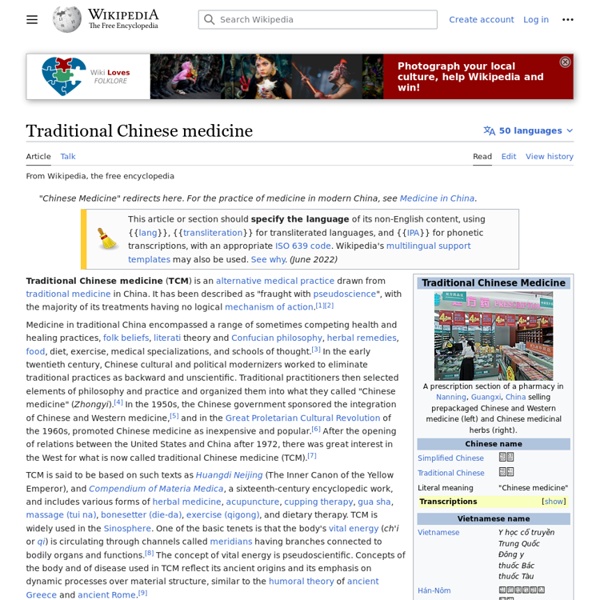Chinese herbology
Dried herbs and plant portions for Chinese herbology at a Xi'an market Chinese herbology (simplified Chinese: 中药学; traditional Chinese: 中藥學; pinyin: zhōngyào xué) is the theory of traditional Chinese herbal therapy, which accounts for the majority of treatments in traditional Chinese medicine (TCM). The term herbology is misleading in the sense that, while plant elements are by far the most commonly used substances, animal, human, and mineral products are also utilized. Thus, the term "medicinal" (instead of herb) is usually preferred as a translation for 药 (pinyin: yào).[1]
Sundial
SSW facing, vertical declining sundial on Moot Hall, Aldeburgh, Suffolk, England. A combined analemmatic-equatorial sundial in Ann Morrison Park in Boise, Idaho, 43°36'45.5"N 116°13'27.6"W A sundial is a device that tells the time of day by the position of the Sun.
Human
Humans began to practice sedentary agriculture about 12,000 years ago, domesticating plants and animals which allowed for the growth of civilization. Humans subsequently established various forms of government, religion, and culture around the world, unifying people within a region and leading to the development of states and empires. The rapid advancement of scientific and medical understanding in the 19th and 20th centuries led to the development of fuel-driven technologies and improved health, causing the human population to rise exponentially. By 2012 the global human population was estimated to be around 7 billion.[10][11] Etymology and definition
Be Beauty Smart: Face Map - What's your acne telling you?
Outbreaks on your forehead can be caused by a toxin build up, usually related to poor digestion and lack of water. Drinking water helps to flush out the toxins in your body, so boost your water intake and have a look at the foods you are eating. Remember, you should be having at least 8 large glasses of water every day. Minimise your intake of fizzy drinks and high caffinated drinks. Also look at switching to herbal teas, especially green tea!
Pausinystalia yohimbe
Pausinystalia yohimbe (Yohimbe), formerly known as Corynanthe yohimbe and sometimes spelled johimbe,[1][2] is a psychoactive plant that contains the MAOI alkaloid yohimbine. It is widely distributed over-the-counter as an herbal aphrodisiac. Originating from the bark of an Africa tree, it has been purported to be helpful for men with erectile dysfunction (ED). This herbal medication can cause tachycardia[citation needed] and hypertension[citation needed] if improperly dosed and should generally only be used under the supervision of a practitioner knowledgeable in herbal medicine. In addition to yohimbine, Yohimbe also contains 55 other alkaloids.
Ancient Egyptian technology
Ancient Egyptian depiction of women engaged in mechanical rope making, the first graphic evidence of the craft, shown in the two lower rows of the illustration Technology in Dynastic Egypt[edit] Significant advances in ancient Egypt during the dynastic period include astronomy, mathematics, and medicine. Their geometry was a necessary outgrowth of surveying to preserve the layout and ownership of farmland, which was flooded annually by the Nile river. The 3,4,5 right triangle and other rules of thumb served to represent rectilinear structures, and the post and lintel architecture of Egypt.
Human Cells have Electric Fields as Powerful as Lighting Bolts -A Galaxy Insight
Using newly developed voltage-sensitive nanoparticles, researchers have found that the previously unknown electric fields inside of cells are as strong, or stronger, as those produced in lightning bolts. Previously, it has only been possible to measure electric fields across cell membranes, not within the main bulk of cells, so scientists didn't even know cells had an internal electric field. This discovery is a surprising twist for cell researchers. Scientists don't know what causes these incredibly strong fields or why they' are there.
The Kidney Meridian - Root of Life
Reservoir of EnergySeat of Courage and Willpower The kidney meridian is a yin meridian (flows upwards), controls the growth and development of bones and nourishes the marrow, which is the body's source of red and white blood cells. A weak kidney is therefore a prime cause of anemia and immune deficiency. In traditional Chinese medicine, the spinal cord and the brain are forms of marrow, and therefore poor memory, inability to think clearly, and backache are all regarded as indicators of impaired kidney function and deficient kidney energy. Read also: Kidney Cleanse
Rauwolfia serpentina
Rauvolfia serpentina, or ' Indian snakeroot' or 'sarpagandha' is a species of flowering plant in the family Apocynaceae. It is native to the Indian Subcontinent and East Asia (from India to Indonesia).[2][3] Medicinal uses[edit] Rauvolfia serpentina contains a number of bioactive chemicals, including yohimbine, reserpine, ajmaline, deserpidine, rescinnamine, serpentinine. The extract of the plant has also been used for millennia in India – Alexander the Great administered this plant to cure his general Ptolemy I Soter of a poisoned arrow. It was reported that Mahatma Gandhi took it as a tranquilizer during his lifetime.[4] It has been used for millennia to treat insect stings and the bites of venomous reptiles.
Metallurgy
Georgius Agricola, author of De re metallica, an important early work on metal extraction Metallurgy is a domain of materials science and materials engineering that studies the physical and chemical behavior of metallic elements, their intermetallic compounds, and their mixtures, which are called alloys. Metallurgy is also the technology of metals: the way in which science is applied to the production of metals, and the engineering of metal components for use in products for consumers and manufacturers.
Health: Nutrition
18 June 2014Last updated at 16:26 The human body needs a balanced diet to deliver vital nutrients What's your idea of a perfect meal? Sushi? A large piece of cake followed by hot chocolate?



